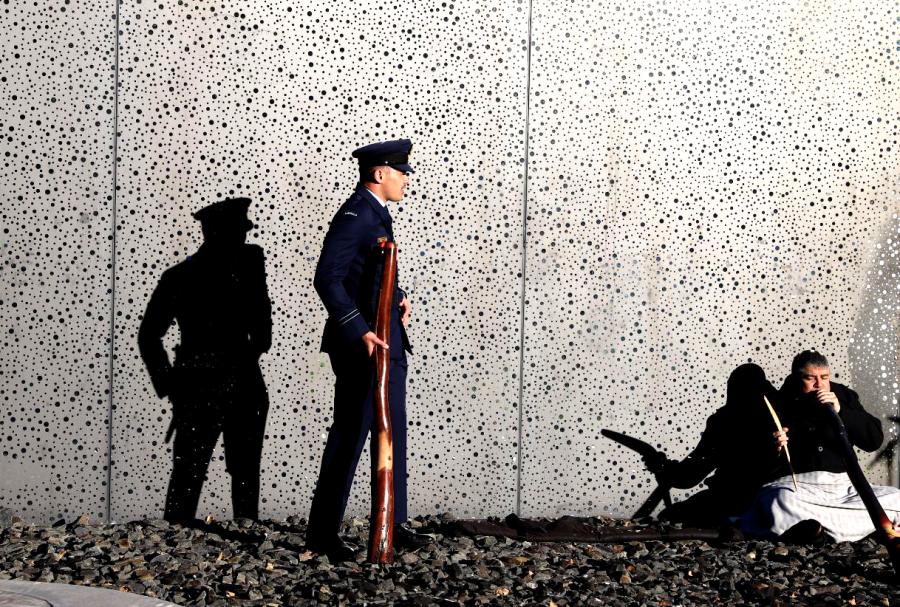[Disclaimer: Aboriginal and Torres Strait Islander people should be aware that this story contains images and names of deceased persons. All photos courtesy of the Australian War Memorial.]
Seven and a half thousand Aboriginal and Torres Strait Islander people served Australia in the two World Wars – but too few know of their contribution.
“We’ve got large numbers of men and women who did serve,” says Michael Bell, the Australian War Memorial‘s Indigenous liaison officer, “and yet it’s unknown, and it’s not as well thought of, in the mainstream.”
He wants to “put the Indigenous face on the Anzac legend, and dispel all the stereotypes that Aboriginal people didn’t defend Australia, and didn’t go to fight”.
Eighty Indigenous people landed at Gallipoli; five were in the Charge of Beersheba; others were killed at Villers-Bretonneux.
“These are the stories of that involvement that resonate with people, because they just didn’t think the Aboriginal soldiers were there,” Mr Bell said.
In World War II, the ‘rats of Tobruk’ included 40 Aboriginal people, while some walked the Kokoda Trail – like Gunner Augustus Briar, a Ngunnawal man from Yass, and whom Mr Bell considers a local hero.
“He’s an ordinary soldier, a Private, who put up his hand to fight when the country needed him most, and paid the ultimate sacrifice,” Mr Bell said. “He’s a man who wanted to defend Country, and went away to do it.”
But in the days of the White Australia Policy, their country didn’t always want them.
At the start of WWI, section 60(h) of the Defence Act 1903 exempted “persons who are not substantially of European origin or descent” from War service. In 1916, military guidelines stated: “Aboriginals, half-castes, or men with Asiatic blood are not to be enlisted. This applies to all coloured men.”
“It was a white man’s war,” Mr Bell said. “They didn’t want men of colour.”
Despite racist policies, the AWM notes that many Indigenous people were accepted early in the war, if they had not lived in tribal environments, while others pretended not to be Aboriginal.
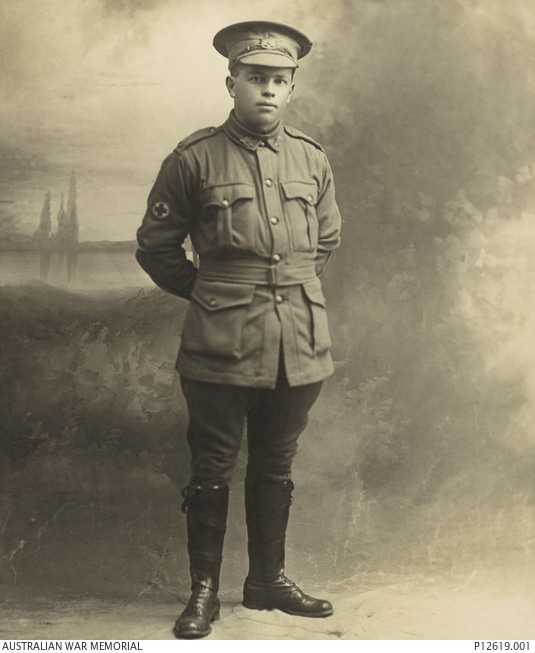
Photo: Australian War Memorial.
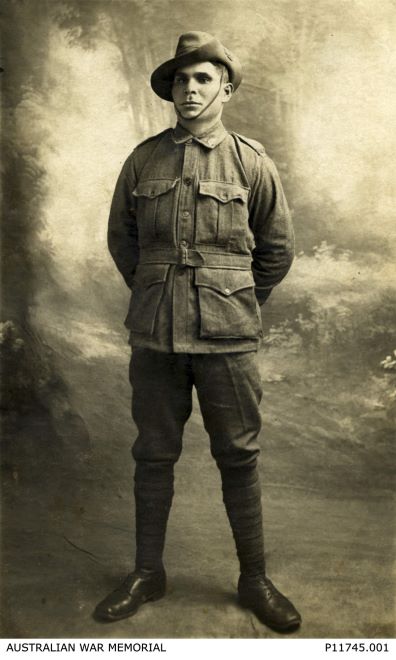
Photo: Australian War Memorial.
In mid-1917, following the carnage of the Western Front and the failure of two conscription referendums, military order 200 stated that “half-castes” could enlist if a medical board were satisfied they had a parent of European origin. But 150 Aboriginal men were rejected because of race, such as Ernest Roy Wilson, a South Australian man who enlisted in June 1917. Despite “good” conduct and character, he was discharged within three months, found medically unfit. “Half-caste Aboriginal, too near full-blood for AIF,” the medical board determined.
“A fairly vicious racist doctor refused people of colour in South Australia,” Mr Bell stated.
Nevertheless, some of the Aboriginal people rejected successfully re-enlisted, even if they had to travel hundreds of kilometres to do so.
“This is the hurdle that Aboriginal people faced not only in legislation but in society,” Mr Bell said. “This is why the recognition is important to a cohort that didn’t receive that recognition at the time; they didn’t receive the recognition because it was presumed that because we weren’t allowed to serve, we didn’t.”
Altogether, it is estimated 1,192 Indigenous men volunteered to enlist in the AIF in World War I (possibly as many as 1,300, Mr Bell believes); 929 served overseas; and 250 to 300 were killed.
They served, the Memorial states, in all branches and units of the AIF (light horse, artillery, engineers, and flying corps); fought in the Middle East and on the Western Front; and were decorated for gallantry in the field, including four Distinguished Conduct Medals and 26 Military Medals. Some become officers, like Lt. Alfred John Hearps and Lt. Col. Charles Melbourne Johnson. Five Indigenous men served in the Navy, and two Indigenous women as nurses.
While official policy may have been abhorrent, the servicepeople themselves may have been more open, the Department of Veterans’ Affairs suggests. One veteran said a Queensland Aboriginal man “became his brother, and was his brother still”, while a nurse declared there was “no discrimination on the battlefield, and certainly none in the military hospitals”.
But, AIATSIS notes, Indigenous soldiers were not give settlement land when they returned, unlike their white comrades.
“Assessment procedures were prejudiced against them, and many were rejected from the scheme – particularly punishing because the scheme offered lands that had always been Aboriginal and Torres Strait Islander lands.”
World War II
Australia maintained its racist policy at the start of World War II. “Australians of non-European origin or descent” could not join the Army or Navy, DVA records. There was no colour bar in the RAAF; Aboriginal men such as Warrant Officer Len Waters and Pilot Officer David Paul DFC flew planes.
Some Indigenous people, however, managed to enlist, and fought in the Western Desert, Greece and Crete, and in Syria, the AWM states.
But the experience of the volunteer members of the Wangaratta ‘Special Platoon’ was also typical. Public opinion and media coverage was positive, the AWM states, but the Defence Committee declared Indigenous enlistment was “neither necessary nor desirable”, claiming that white soldiers might object. The unit was disbanded, and the men were discharged; four, however, re-enlisted, Mr Bell said.
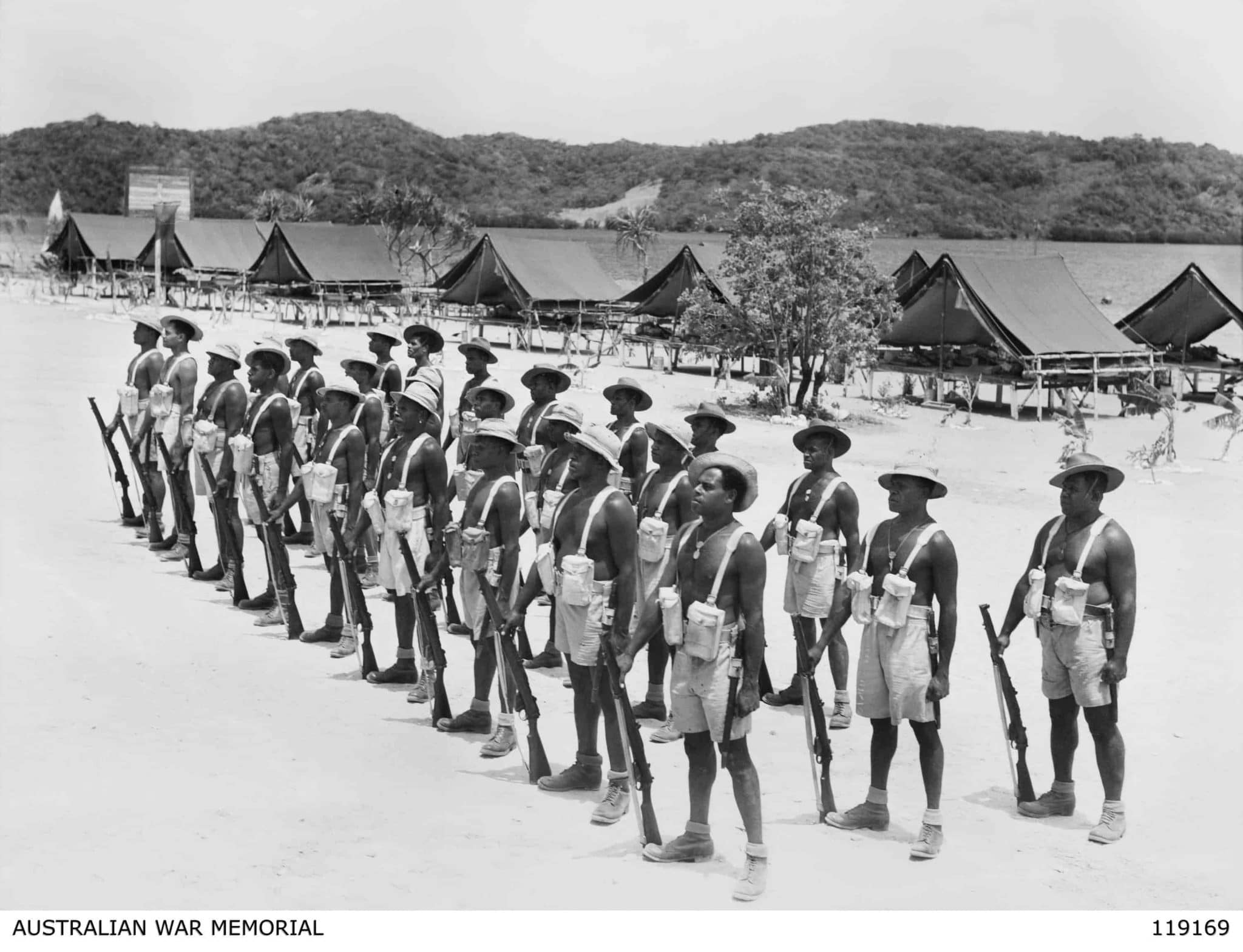
Restrictions on Indigenous service loosened in 1942 when Japan entered the War, and Aboriginal and Torres Strait Islander soldiers fought in Malaya and Singapore, in Papua New Guinea, Bougainville, and Borneo, the AWM states.
Altogether, an estimated 6,500 to 7,000 Indigenous men and women served in WWII. They include Lt. Reg Saunders, the first openly Aboriginal officer, later promoted to captain, who received the MBE, and Corporal Timothy Hughes, awarded the Military Medal, and later the first chairman of the Aboriginal Lands Trust.
Some, the DVA states, served in skilled militias defending the coastline, such as the Torres Strait Islander Battalion, the Northern Territory Special Reconnaissance Unit (NTSRU), or the Navy’s ‘Snake Bay’ patrol. Others were civilian labourers: farm assistants, builders, butchers, domestic staff, drivers, fishermen, mechanics, munitions factory workers, and stevedores.
Indigenous women joined the Australian Women’s Army Service, the Women’s Australian Auxiliary Air Force, and the Australian Women’s Land Army; they worked, the DVA notes, as clerks or in communications, as cooks, cleaners, and kitchen staff, as drivers, and as nurses.
But many were still subjected to racist policies and discrimination. The Torres Strait Islander Battalion was paid only a third of a soldier’s normal pay (raised to two-thirds when they went on strike), while the NTSRU were given rations of tobacco and fishing and hunting supplies.
The Battalion did not get its full back pay until 1986, while the NTSRU received no back-pay or medals until 1993.
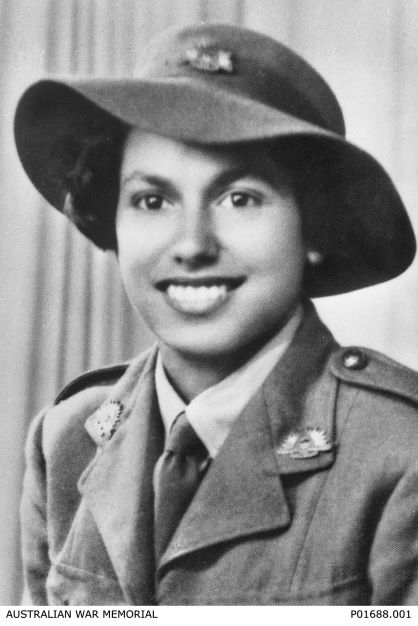
Similarly, the DVA notes, some civilians were expected to work for room and board only, paid lower wages, or not given their pay – but for some Indigenous people from mission stations and reserves, this was the first time they earned a cash wage, and food, housing, and welfare services were better than they experienced before the War.
Even serving Indigenous soldiers wearing uniforms were refused drinks, while several men, fed up with being treated differently because of the colour of their skin, went AWOL and were court-martialled.
After the war, DVA notes, many ex-servicemen were rejected from hotels and public places (like Lance Corporal Desmond Parfitt), or denied employment and benefits offered to other returning service personnel.
“We lived in an unequal society, and the rules of the day in place didn’t allow Aboriginal men access to alcohol,” Mr Bell said. “More importantly, they also discriminated against us earning a fair wage; they restricted our movement; and they restricted our ability to marry. You had to seek permission to have an interracial marriage. A lot of people don’t realise that.”
Aboriginal people, he said, hoped to use service as a pathway to citizenship. “But that didn’t happen.” Instead, meeting African-American soldiers, “who were about 25 years ahead of us toward civil rights … guided them down the path of non-violent activism”.
That was the experience of Kath Walker – more famous as poet and activist Oodgeroo Noonuccal – who worked as a signaller in Brisbane.
Mr Bell also pointed to Vincent Lingiari and the Gurindji stockmen at Wave Hill, NT. Paid cash by the Army as stockmen – a protected industry, breeding cattle to feed the Americans –they went on strike because food company Vestey Brothers paid them less, and wanted them to go back to rations. That, Mr Bell said, was the catalyst for the NT land rights movement; Labor under Gough Whitlam passed legislation allowing Aboriginal people to claim land title.
Later conflicts and the present day
Eighty Aboriginal and Torres Strait Islander people served in the Korean War. Reg Saunders, now a captain, commanded a company at the battle of Kapyong (1951), which blocked the Chinese advance on Seoul.
Five hundred served in the Vietnam War, more than 225 from the Army.
More recently, Indigenous people have served with the ADF in Somalia, East Timor, Afghanistan, Iraq, and on peacekeeping operations.
“The modern ADF has bent over backwards to encourage and accept Aboriginal and Torres Strait Islander people,” Mr Bell said.
The Department of Defence has a Reconciliation Action Plan; an Indigenous protocol document; includes the smoking ceremony in the official military ceremony; and understands sorry business, he said.
“The ADF is probably the most advanced government agency in Australia on recognition of Indigenous policy and protocol, and employment, retention, and recruitment of Aboriginal and Torres Strait Islander people,” Mr Bell said.
Similarly, an Aboriginal War memorial, For our Country, was built in 2018 to recognise the military service of Aboriginal and Torres Strait Islander peoples.
The Aboriginal and Torres Strait Islander Veterans and Services Association (ATSIVSA) will hold a commemorative ceremony here on Anzac Day.
Much has changed in the last 80 years, but Mr Bell believes there is still much to be done. The wartime service of many Indigenous people is still unknown.
He encourages the public – particularly Indigenous families, families of non-Indigenous servicepeople who are aware of Indigenous service – to visit the AWM website, look at the Indigenous service list, and let the AWM know if the list misses any names.
“So we can give them that recognition, and build up a fuller picture of the contributions of our people.”
Mr Bell also believes Australia should hold a truth commission for the stories of mistreatment to be openly told and openly spoken about, so that “everybody can understand the full impact of what it is to have a racist policy, the actual implications”.
“We have to use this learning as a step towards reconciliation,” Mr Bell said. “Our commonalities bring us together. We can put the Indigenous face on Gallipoli, on Passchendaele, on the Western Front, on Beersheba, on Kokoda, and all the way through all the other important wars in Vietnam, in modern day Iraq, Afghanistan, and the Middle East.
“We have Aboriginal soldiers and sailors and airmen now defending us. We’re in all the services, all the conflicts, in peacekeeping, all the way through. So that’s the story we need to get to.
“But the difficulties of getting in, and the society we came back to, that’s what we have to keep informing the broader mainstream public.”

